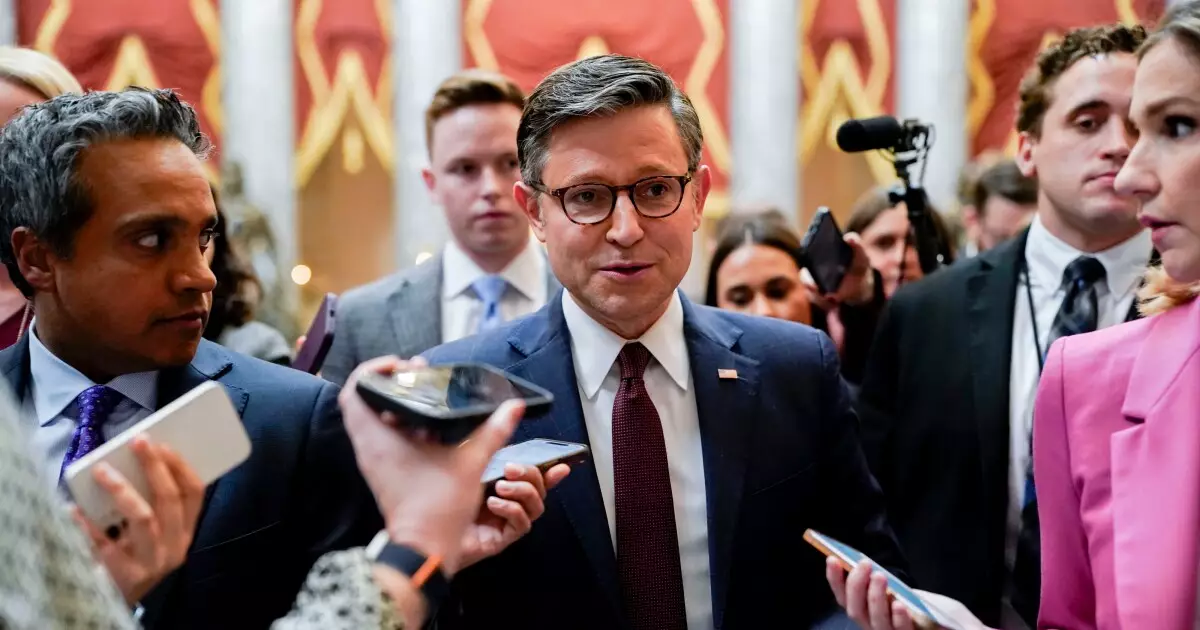In a decisive move that could reshape the fiscal landscape of the United States, the House of Representatives passed a crucial budget resolution on Tuesday evening, laying the groundwork for a far-reaching tax reform initiative. This pivotal step, heralded by House Speaker Mike Johnson (R-La.) as a significant advancement of President Trump’s comprehensive “America First” agenda, exemplifies the ongoing tug-of-war within Congress as party members grapple with their differing priorities. With a narrow margin of victory—217 votes in favor to 215 against—it demonstrates the precarious nature of the Republican majority, which is currently held at 218 to 215 seats.
The final tally showcased not only the fragility of party unity but also highlighted the critical choices lawmakers are faced with as they navigate a potentially contentious process of budget reconciliation. Notably, Kentucky’s Rep. Thomas Massie broke ranks as the lone Republican opposing the resolution, symbolizing the intraparty rifts that continue to pose challenges for the GOP.
The proposed budget framework outlines an ambitious goal of $4.5 trillion in tax reductions, primarily by extending the 2017 Tax Cuts and Jobs Act (TCJA), a keystone piece of legislation from President Trump’s initial term. The plan anticipates cutting approximately $2 trillion from various programs, with Medicaid slated as a significant target, raising considerable concerns about the potential ramifications for vulnerable populations. Combined with a $4 trillion increase in the debt ceiling, the proposed budget signals a bold fiscal strategy, albeit one that will likely incite fierce debate on both sides of the aisle.
Central to the discussions is the future of the municipal bond market, which stands to be heavily impacted by any revisions to the tax exemption of municipal bond interest—a mainstay that many local governments rely upon for funding infrastructure and services. The American Municipal Association is already mobilizing to advocate for the preservation of this tax provision, urging lawmakers to resist any moves that would jeopardize the financial flexibility of municipalities across the nation.
As the legislative process unfolds, the house now faces the critical task of negotiating its budget resolution with Senate Republicans, who have recently approved their own budget plan—valued at $340 billion—that does not incorporate tax reform. Senate leaders are advocating for a permanent extension of the TCJA, which introduces an additional layer of complexity given their differing fiscal methodologies. Lindsey Graham, the Senate Budget Committee Chair, has labeled the House’s proposed $4.5 trillion in cuts as “a nonstarter,” amplifying the necessity for bipartisan negotiations if the two chambers intend to converge on a consensus.
The upcoming weeks will be crucial as GOP leaders will be tasked with rallying sufficient votes for a final reconciliatory tax package. This becomes particularly pressing as Congress must simultaneously navigate the impending threat of a government shutdown when current funding runs out on March 14. Top appropriators and key Republicans are scheduled to convene shortly to strategize on this dual front, emphasizing the urgency of their undertaking.
SALT Deduction and High-Tax States
An additional focal point within this financial discourse is the contentious debate surrounding the state and local tax (SALT) deduction cap, an issue that resonates deeply in high-tax states like New York and California. Representatives from these regions, including Congressman Mike Lawler (R-NY), have voiced strong support for revisiting the cap, asserting that lifting it is vital for restoring financial equilibrium and flexibility for their constituents. The stewardship around SALT deductions not only reflects regional interests but also showcases the broader challenges that lawmakers face as they negotiate competing priorities.
As the House prepares for the next phase of negotiations, the results of this vote set a transformative yet contentious trajectory for tax policy in the U.S. The converging agendas of House and Senate Republicans, combined with the lobby from municipal and state representatives, create a complex tapestry that will shape the nation’s economic future. The road ahead is sure to be riddled with obstacles, yet it underscores a pivotal moment for the Republican party as they endeavor to align their fiscal philosophy with the realities of governance in a deeply divided Congress. As discussions advance, all eyes will remain keenly focused on the outcomes that emerge from these high-stakes deliberations.

